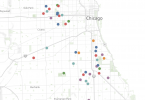Chicago attracting more young, well-off residents
If you think you’ve been seeing a lot more bright young people living in Chicago lately, you have.
Between 2010 and 2016, the city of Chicago gained more households in a key category—total income of more than $100,000 with the head of household under age 45—than any city in the country except for far larger New York, according to newly analyzed U.S. Census Bureau data.
Specifically, the number of such households here grew from just under 105,000 to an estimated 131,000, according to the American Community Survey data. That increase of 26,000 led Houston (24,000), San Francisco (23,000), Washington, D.C. (19,000) and Los Angeles (16,000). And while on a percentage basis that demographic grew faster in San Francisco than in Chicago (57 percent versus 27 percent), the Windy City outpaced cities such as Houston and L.A. and tied red-hot Denver.
The data suggest that Chicago definitely has something to offer Amazon as it narrows its search for a second headquarters: lots of emerging young talent, which has begun to earn a sizable wage but is not yet old enough to pull in really big bucks. You can bet that city officials will pass on those figures if they haven’t already done so. It also explains why the number of high-end rental apartments being built downtown continues at a rapid clip: The market of potential customers is surging.
But as Chicago’s overall population continues to dip, driven by the departure of tens of thousands of African-Americans each year, there’s another side to the data: Blacks largely are being left out of the party.
As crunched by Chicago demographers Ed Zotti and Mike Rothschild, the data indicate that the growth in the over $100K/under 45 group is heavily concentrated in the central area of the city and neighborhoods to the north, including Logan Square, Lake View and the Near West, Near North and Near South sides. Predominantly black neighborhoods showed minor growth in the over $100K/under 45 group over the past six years and, in some cases, had fewer households of this type in 2016 than they did in 2010 despite a marked recovery in the economy nationally.
Chatham lost almost half of its younger, higher-income households, with the total decreasing to 265 from 520.
“Chatham traditionally has been at the center of the black middle class,” Zotti said. “These new figures are not good.”
To Zotti and some other experts who have studied recent trends, the data suggest that Chicago is undergoing a transformation or repositioning of sorts, with some groups quickly growing and others quickly declining. While the city’s overall population has dropped a little, previous research indicates that the decline is concentrated among blacks, with the number of whites, Latinos and Asians rising.
Also increasing is the share of Chicagoans with college degrees. The percentage holding at least a bachelor’s degree is the highest of any of the country’s five biggest cities.
Zotti and Rothschild also looked at a related set of data: the number of truly high-end households, those with incomes of at least $200,000. That group grew even faster in Chicago than the over $100K/under 45 group, rising 65 percent to just over 75,000, according to the ACS data. The percentage growth was better than New York’s 58 percent and L.A.’s 60 percent, but lagged not only San Francisco and San Jose but Houston, Denver, Philadelphia and some other cities.
What’s not clear is whether the relatively stronger growth in the $100K group later will carry over to the $200K group, or whether young talent eventually will move to other regions of the country.
“I think the data shows we’re a hospitable place for younger educated people who earn decent money but still are toward the beginning of their career ladder,” Zotti said. “We don’t know” what will happen later.
http://www.chicagobusiness.com/article/20180530/BLOGS02/180539986








